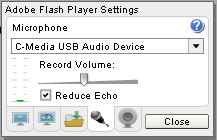
- Is adobe flash necessary to hear audible recordings how to#
- Is adobe flash necessary to hear audible recordings install#
- Is adobe flash necessary to hear audible recordings software#
- Is adobe flash necessary to hear audible recordings free#
To remove background noise from a video, you need to get appropriate software.
Is adobe flash necessary to hear audible recordings how to#
In the video below, you’ll see how to get rid of background noise in Audacity using this tool. It’s best for reducing continuous noise like street sounds and a fan turned on. It’s the easier one because it requires less settings tweaking. The first one is via the Noise Reduction tool. Two options in Audacity remove background noise. Which means, again, installing additional software. So, you’ll have to get a video editor to combine the new audio with the video file and erase the old audio track. Another disadvantage is that even though you can import videos into the program, you cannot export them back as videos.

Is adobe flash necessary to hear audible recordings software#
While opening a file in Audacity, watch out for error messages – they should point out the software you need to install. The most common requirements are FFmpeg and Lame.
Is adobe flash necessary to hear audible recordings install#
First of all, you may need to install additional software to make the app open your files. However, there are a few difficulties you can face.
Is adobe flash necessary to hear audible recordings free#
The main advantages of Audacity are that it’s free and has plenty of audio-editing features. The app’s interface may look a bit confusing for a beginner, but there are many tutorials online that will explain every aspect of the software in detail.

The software lets you upload or record audio and then edit it: add fade-in and fade-out, change speed and tempo, normalize the sound, reduce echo, and make the sound cleaner. Kevin Purdy is a senior editor at Lifehacker, a daily technology and productivity blog.Audacity is free noise reduction software for Windows, Mac, and Linux operating systems. With that in mind, check to see if that site has a mobile-centered version - usually m.,, or occasionally /i - and use that from your desktop browser, at least until the world comes around to your principled stance on plug-ins. Then again, more and more developers are taking this into consideration, as owners of iPhones and other web-enabled but Flash-free phones become a larger part of their audience. What happens when you reach a site that needs Flash for the most basic navigation and use? The high-minded answer is to write a calm, concise, and courteous email to the site's webmaster (listed at the very bottom of each page, usually), asking them to take pity on users without Flash.

The high-definition video site Vimeo also offers an HTML5-based player for the same range of browsers, accessed by clicking the "Switch to HTML5 Player" link below any video, and Dailymotion offers an OpenVideo section that, while tailored toward Firefox users, will also work on Chrome and other browser setups, though likely with hiccups.

From then on, the majority of YouTube's videos that can support no-Flash streaming will play inside a strikingly similar video player. You'll need to sign into a valid YouTube/Google account and then head to /html5 and click the "Join the HTML5 beta" link at the bottom. That's all well and good, but what about your lunchtime YouTube fix? If you're using Chrome or Safari on any OS, or Internet Explorer with Google's Chrome Frame installed, you can actually view most videos in their native H.264 format, streaming straight to your browser, through the magic of HTML5.


 0 kommentar(er)
0 kommentar(er)
